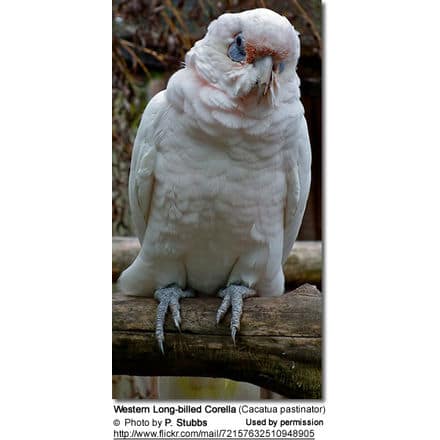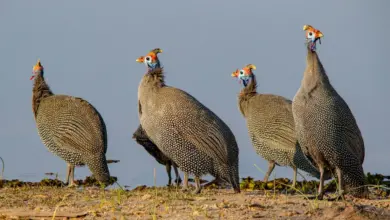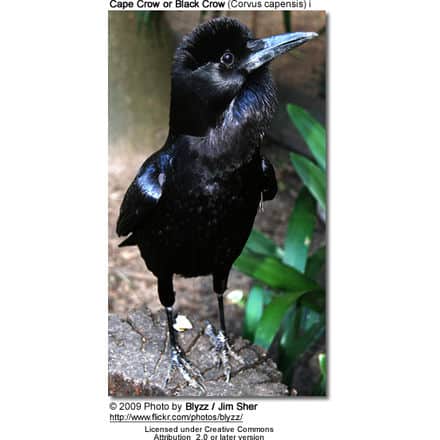Western Corella or Western Long-billed Corella
The Western Corella (Cacatua pastinator) – formerly known as Western Long-billed Corellas – are medium-sized, stocky Australian cockatoos that are closely related, and in fact were formerly lumped together, with the Long-billed Corellas (Cacatua tenuirostris) and the shorter-billed Little Corellas aka Bare-eyed Cockatoos (Cacatua sanguinea).
In captivity, the Long-billed Corellas and the Western Corellas are known to interbreed.
They reach reproductive maturity when they are about 3 – 5 years old and even though most are believed to perish before they reach breeding age, those that survive can expect to live 25 years or even longer.

Distribution / Habitat
These cockatoos are found in the southwestern parts of Western Australia, where they appear to be mostly resident, except for local movements in response to availability of food and water.
There is no evidence of large-scale seasonal migration.
They are most commonly found in / on …
- eucalyptus woodlands dominated by Wandoo, Eucalyptus wandoo, Marri, E. calophylla, or Jarrah, E. marginata;
- farmland, particularly croplands and sometimes pasture with ample watering points and nearby large trees for roosting or breeding; and to a lesser extent
- open sand plains, where they may be seen perching in the tops of dead trees.
Subspecies and Ranges:
- Western Long-billed Corella / Muir’s Corella (Cacatua pastinator pastinator – Gould, 1841) – nominate form
- Populations are concentrated around Lakes Muir and Unicup in extreme south-west of Western Australia, specifically from McAlinden and Qualeup, south to the lower Perup River and Lake Muir, and east to Rocky Gully and Frankland. They are mostly found in pairs and small flocks. However, at productive feeding sites or at bodies of water up to 1,000 of them may be seen.
- Butler’s Corella (Cacatua pastinator butleri – Ford, 1987. Also labeled as Cacatua pastinator derbyi – Mathews, 1916; however, butleri believed to be more applicable).
- This northern race is found in northern and central wheatbelt of south-west Western Australia – between the towns of Dongara, Moora and Quairading.
- ID: Significantly smaller than the nominate form with a shorter bill.

Description
Size
The Western Corellas measure between 17 – 19 inches (43 – 48 cm) in length (including the tail); have a wingspan of about 35 inches (90 cm); and weigh between 19.8 – 30.3 oz (560 – 860 g).
Plumage Details / Adults
The plumage is mostly white with a prominent orange-red wash over the lores (area between the eyes and the bill) and a strong yellow wash on the undersides of the wings and tail.
The feathers of the head, neck and chest have orange-red basis that are usually only exposed during preening or if ruffled by the wind.
Other Physical Details
The eyes are dark brown with a ring of blue-grey skin around each eye (more extensively beneath the eyes). The bill is pale-grey to off-white. The legs and feet are grey.
Gender ID
The male and female look alike.
Juvenile Description
Immature birds resemble adults; except …
- there is minimal orange-red on the lores;
- there is a slight yellow wash over the ear coverts (feathers covering the ears), upper parts and on the plumage below;
- the bare eye rings are less pronounced and paler with a wash of pink under the eye; and
- the upper bill is shorter and smoother than in adult birds who tend to have flaky bills.
Diet / Feeding
Their diet consists mostly of seeds from grasses and other plants; but they also feed on cereal crops, insect larvae, flower heads, leaves, bulbs, roots, corms, tubers, fruits, and, possibly, nectar. They also seek out artificial grain-sources, including silos, pigpens and grain-fed cattle and sheep.
They use their long upper bill to dig in the ground for roots, pluck seeds from the heads of standing cereal crops; pull up seedlings and bite through stems of thistles to feed on their seeds.
Breeding / Nesting
Most breeding activities are observed from September to November with isolated breeding occurring into summer and autumn.
Pairs are monogamous and share the tasks of preparing the nest site, incubating the eggs and raising the young.
They usually nest at the base of hollow limbs, or in cavities of large living or dead trees. The nest floor is covered with rotten wood or wood dust. Pairs may reuse the same nest over subsequent seasons.
A clutch consists of 1 – 4 white eggs that are incubated for 26 – 29 days.
Both parents brood, feed and protect the young. The chicks remain in the nest for about 53 – 67 days and are typically independent about 3 months after fledging.
Calls / Vocalizations / Sounds
Their vocalizations are described as chuckling with three notes; shrill shrieks or screeches (when agitated / alarmed); or shorter disyllabic calls, with a second tone that is more high pitched.
https://www.xeno-canto.org/embed.php?XC=40702&simple=1
Alternate (Global) Names
Chinese: ??????? … Czech: Kakadu hrabavý … Danish: Næsekakadu … Dutch: Oostelijke Langsnavelkaketoe … German: Wühlerkakadu … Finnish: Lännenkoukkukakadu … French: Cacatoès à nez rose, Cacatoès à oeil nu, Cacatoès à oil nu, Cacatoès laboureur … Italian: Corella beccolungo orientale, Corella occidentale … Japanese: Himetenjikubatan … Norwegian: Nakenøyet kakadu, Vestkakadu … Polish: kakadu dlugodzioba, kakadu d?ugodzioba … Russian: ???????? ?????? … Slovak: kakadu kopác, kakadu kopá?… Spanish: Cacatúa Cavadora … Swedish: Västaustralisk kakadua
More Cockatoo Resources:
- Cockatoo Information
- Cockatoos as Pets
- Photos of the Different Cockatoo Species (for Identification) …
- Index of Cockatoo Species
- Common Health Problems of Cockatoos
- What is it: Male or Female?
- Cockatoo Species Data (Range, Eggs and Incubation)
- The Taxonomy Of Cockatoos
- Cockatoo Nutrition / Diet






